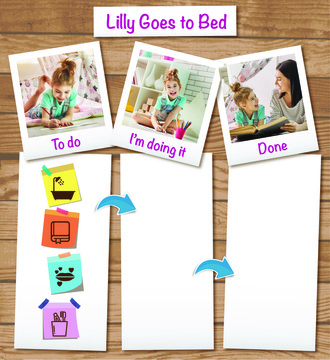There’s probably not a parent alive who isn’t familiar with Adam Mansbach’s book Go the F**k to Sleep.
Mansbach’s raw, honest and hilarious verses capture so aptly the sentiments of every parent who has experienced the frustration of overtired, under-slept children –especially the terror we feel when it comes to putting those little darlings down to sleep at night.
Putting tired, cranky littlies to bed tests most parents’ skills and patience. What should be a time of calm can turn into a marathon of negotiations and excuses – ‘I’m not tired’, ‘I’m thirsty’, ‘I need to go to the toilet’, ‘I’m part of the family too’ and more.
When a good sleep environment is combined with a good sleep routine, you will be well on your way to mastering the good sleep formula.
Turning the bedroom into a sleep sanctuary and following a consistent ‘go to bed’ routine can make a big difference in just two to four weeks. In this post, I give you my top tips for setting a failsafe bedtime routine.
Preparing for a good sleep starts with what you do in the day, as daytime behaviour problems are likely to lead to night-time shenanigans.
Make sure your littlie has had good physical exercise and gets outside into the daylight. Ideally, running around and physical activity should wind down at least six hours before bedtime.
Nutrition is also vital for good sleep. Your kids should be eating regular meals and snacks, predominantly healthy, unprocessed foods without additives and sugar.
Factor any daytime naps into your child’s overall sleep quantity. If there’s been a disruption to sleep due to a party or visitor, make sure you schedule a nap the next day, ensuring your child gets the correct number of hours sleep. (Check out the sleep table in this post).
As modern parents, we must be mindful that the increase in technology use is eroding kids’ sleep. Screen use can cause overstimulation, add busyness to the daytime schedule and push out bedtimes – not to mention the interference with melatonin release caused by the blue light screens emit.
Ensure that any use of screens is relaxing and cut out daytime TV or particular shows if you think they are contributing to bedtime shenanigans. Screens should be off at least an hour before bed (this goes for adults too).
Discussions about bedtime should be non-negotiable.
You can give your child choices around pre-bed activities, but bedtime itself and the routine itself should remain the same.
Both parents need to be on board with the system – otherwise it will be more likely that one of you will break the routine. The aim should be for a consistent routine, no matter who is helping out with bedtime.
Managing siblings of different ages requires setting fair rules and expectations for older children who may need time with their parents after littlies have gone to bed. One idea is involving older siblings in putting littlies to bed, which can be a special bonding experience.
Your child’s bedtime routine should start at the same time every evening and it might include a number of regular activities, always done in the same order.
To work out the best regular bedtime for your child, you’ll need to ‘reverse engineer’ your day.
Work out the time your kids need to get up in the morning (or the time they always get up), count back the ideal number of hours of sleep for their age, and that will give you the time they need to be asleep.
Then count back another half an hour for the routine and fifteen minutes for them to get to sleep, and you will have a starting time for their bedtime routine every night.
For example, if you have a four-year-old child, their recommended sleep time is around twelve hours. If they take a one-hour nap during the day, that brings the amount of evening sleep they need down to eleven hours. If they wake up at 6:30am, their bedtime routine would therefore need to start at 6:45pm.
- 6:45pm: Start bedtime routine.
- 7:15pm: Tuck in to bed.
- 7:15 – 7:30pm: Time to fall asleep.
- 7:30pm – 6:30am: 11 hours of sleep.
Bedtime should be a special, enjoyable time that kids enjoy and look forward to without getting too hyped up.
There are many activities you might consider including in your child’s bedtime routine. Here are my top ones:
- Bath: A warm bath at least half an hour before bed helps the body fall asleep. Our body temperature cools down after a bath, and this drop in temperature is a trigger for the body to go to sleep. Meanwhile, brushing teeth and going to the toilet are essential activities that ought to be added to the routine after the bath.
- Reading/story time: Reading is a good, quiet activity kids and adults can do before bed. However, reading ideally happens out of bed so that reading is not directly associated with going to sleep – otherwise your child might demand a story when they wake during the night. If reading in bed is your preference, however, finish the story just before they fall asleep. You can say, ‘I see you are ready for sleep now. Night-night and sweet dreams.’
- A snack: Snacks like oatmeal, a banana, or milk are on the recommended list for kids who need a snack an hour before bed. Avoid caffeinated snacks such as chocolate, tea or cola at least four hours before bedtime.
- Movement: Rocking facilitates deep sleep. You can have a cuddle on a rocking chair, or babies can rock on a tummy-time pod.
- Touch: Cuddles and massage can help soothe kids before bed and allow for special bonding time. And of course, encourage your child give a hug and kiss goodnight to all family members and special toys.
- List for tomorrow: Making lists for the next day can help quell anxiety. They are also useful for little ‘chatterboxes’ who start talking as soon as they get into bed. Have a notepad and write it down: ‘Will talk about the dinosaur picnic with Lily in the morning.’
- Music and meditation: You and your child could listen to a guided meditation or some soft music before going to bed.
Once a bedtime routine is set, the time required for the routine may decrease as the brain adapts and associations trigger the process of ‘falling to sleep’. Once a routine is well established, children find it possible change temporarily – when sick or travelling, for example – and then return to familiar patterns.
It’s important to go to bed at a consistent time with a consistent routine. It’s just as important to wake up at the same time every day and follow a consistent morning routine.
Waking up to the soothing voice of mum or dad, perhaps with a little back rub, is a pleasant way for little ones to start the day. Praise and good moods are a great way to start the day, so find lots of little things to smile about.
Or, if your child can read a digital clock, you can teach them when they are allowed up by reading the number on the clock (it might need to say 7:00, for example). Set rules around what they can do if they are up earlier than everyone else.
Get breakfast options ready the night before so your child can start off with good nutrition. For early risers, you could have some muesli bars or bananas in a bowl that they can easily reach. On a weekend, maybe you can provide breakfast in bed!
And finally, try to expose your child to daylight as early as possible. Getting sunlight in the morning and during the day helps to regulate melatonin production and reinforce the sleep/awake clock.
It’s never too late to start
While establishing a routine can feel like a lot of work, especially if you and your kids are sleep deprived, it is worth putting in the time and energy into getting it right as early as possible in a child’s life. But if you’ve lived a routine-free life up until this point, it’s never too late to start!
Finally, if the routine is consistent for over two weeks and your kids are still not towing the line, you may need to look further into why. A wired kid may simply need a little more time and more tangible rewards for changing their behaviour … or there could be a deeper concern.
Looking for more?
Let’s build a new generation of healthy sleepers!
With my book Sleep-Wrecked Kids, I support you to become the lifeguard of your child’s sleep. Packed full of information and practical help, it will get you on the way to good sleep for all the family. Order your copy here!



